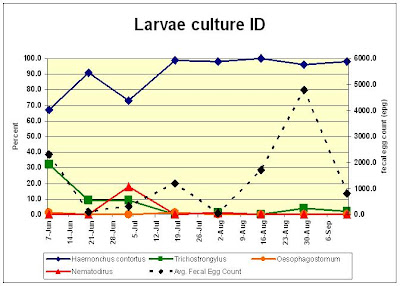The parasites affecting sheep and goats come primarily from the strongyle (roundworm) family. Unfortunately, the eggs of most of these worms look the same when they are examined under a microscope. Consequently, it is necessary to hatch the eggs and look at the larva to identify the exact type of parasite. The test is called a larval development assay or LDA.
At the 2008 Western Maryland Pasture-Based Meat Goat Performance Test, fecal samples were collected every 14 days from the 62 goats on test. Individual fecal samples were sent to Dr. Dahlia Jackson's lab at Delaware State University for fecal egg count detemination, while pooled samples were sent to Dr. Ray Kaplan's lab at the University of Georgia for larval ID.
 For the majority of the testing period, the barber pole worm comprised a whopping 96 to 100 percent of the worm infection. This "single" species worm load meant that the FAMACHA© system could be used to determine which goats required anthelmintic treatment.
For the majority of the testing period, the barber pole worm comprised a whopping 96 to 100 percent of the worm infection. This "single" species worm load meant that the FAMACHA© system could be used to determine which goats required anthelmintic treatment.
